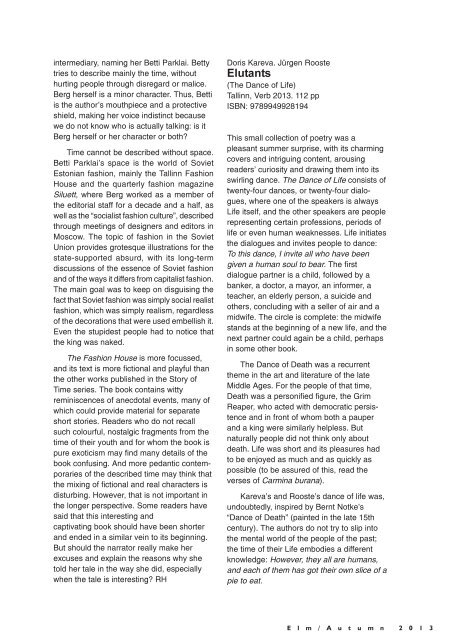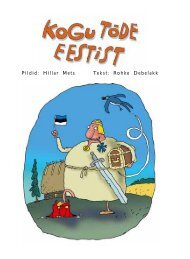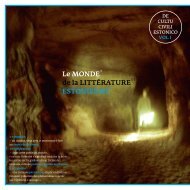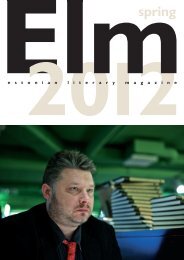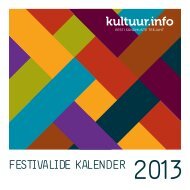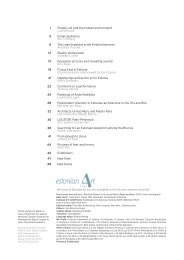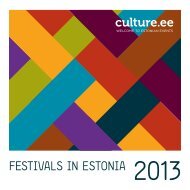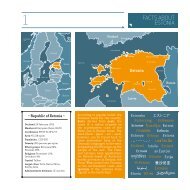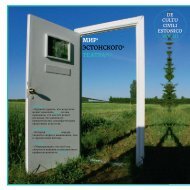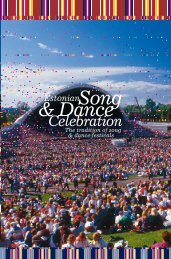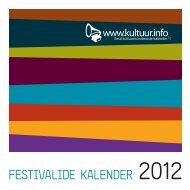Autumn 2013
Autumn 2013
Autumn 2013
You also want an ePaper? Increase the reach of your titles
YUMPU automatically turns print PDFs into web optimized ePapers that Google loves.
intermediary, naming her Betti Parklai. Betty<br />
tries to describe mainly the time, without<br />
hurting people through disregard or malice.<br />
Berg herself is a minor character. Thus, Betti<br />
is the author’s mouthpiece and a protective<br />
shield, making her voice indistinct because<br />
we do not know who is actually talking: is it<br />
Berg herself or her character or both?<br />
Time cannot be described without space.<br />
Betti Parklai’s space is the world of Soviet<br />
Estonian fashion, mainly the Tallinn Fashion<br />
House and the quarterly fashion magazine<br />
Siluett, where Berg worked as a member of<br />
the editorial staff for a decade and a half, as<br />
well as the “socialist fashion culture”, described<br />
through meetings of designers and editors in<br />
Moscow. The topic of fashion in the Soviet<br />
Union provides grotesque illustrations for the<br />
state-supported absurd, with its long-term<br />
discussions of the essence of Soviet fashion<br />
and of the ways it differs from capitalist fashion.<br />
The main goal was to keep on disguising the<br />
fact that Soviet fashion was simply social realist<br />
fashion, which was simply realism, regardless<br />
of the decorations that were used embellish it.<br />
Even the stupidest people had to notice that<br />
the king was naked.<br />
The Fashion House is more focussed,<br />
and its text is more fictional and playful than<br />
the other works published in the Story of<br />
Time series. The book contains witty<br />
reminiscences of anecdotal events, many of<br />
which could provide material for separate<br />
short stories. Readers who do not recall<br />
such colourful, nostalgic fragments from the<br />
time of their youth and for whom the book is<br />
pure exoticism may find many details of the<br />
book confusing. And more pedantic contemporaries<br />
of the described time may think that<br />
the mixing of fictional and real characters is<br />
disturbing. However, that is not important in<br />
the longer perspective. Some readers have<br />
said that this interesting and<br />
captivating book should have been shorter<br />
and ended in a similar vein to its beginning.<br />
But should the narrator really make her<br />
excuses and explain the reasons why she<br />
told her tale in the way she did, especially<br />
when the tale is interesting? RH<br />
Doris Kareva. Jürgen Rooste<br />
Elutants<br />
(The Dance of Life)<br />
Tallinn, Verb <strong>2013</strong>. 112 pp<br />
ISBN: 9789949928194<br />
This small collection of poetry was a<br />
pleasant summer surprise, with its charming<br />
covers and intriguing content, arousing<br />
readers’ curiosity and drawing them into its<br />
swirling dance. The Dance of Life consists of<br />
twenty-four dances, or twenty-four dialogues,<br />
where one of the speakers is always<br />
Life itself, and the other speakers are people<br />
representing certain professions, periods of<br />
life or even human weaknesses. Life initiates<br />
the dialogues and invites people to dance:<br />
To this dance, I invite all who have been<br />
given a human soul to bear. The first<br />
dialogue partner is a child, followed by a<br />
banker, a doctor, a mayor, an informer, a<br />
teacher, an elderly person, a suicide and<br />
others, concluding with a seller of air and a<br />
midwife. The circle is complete: the midwife<br />
stands at the beginning of a new life, and the<br />
next partner could again be a child, perhaps<br />
in some other book.<br />
The Dance of Death was a recurrent<br />
theme in the art and literature of the late<br />
Middle Ages. For the people of that time,<br />
Death was a personified figure, the Grim<br />
Reaper, who acted with democratic persistence<br />
and in front of whom both a pauper<br />
and a king were similarly helpless. But<br />
naturally people did not think only about<br />
death. Life was short and its pleasures had<br />
to be enjoyed as much and as quickly as<br />
possible (to be assured of this, read the<br />
verses of Carmina burana).<br />
Kareva’s and Rooste’s dance of life was,<br />
undoubtedly, inspired by Bernt Notke’s<br />
“Dance of Death” (painted in the late 15th<br />
century). The authors do not try to slip into<br />
the mental world of the people of the past;<br />
the time of their Life embodies a different<br />
knowledge: However, they all are humans,<br />
and each of them has got their own slice of a<br />
pie to eat.<br />
E l m / A u t u m n 2 0 1 3


